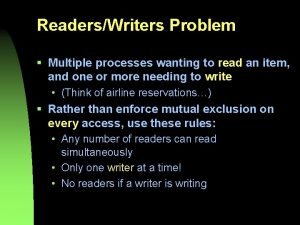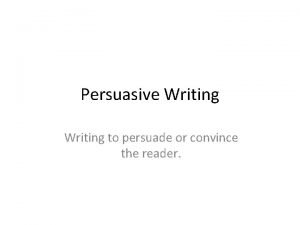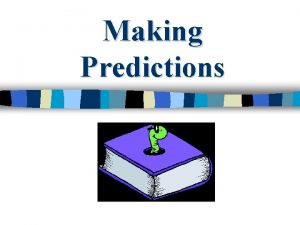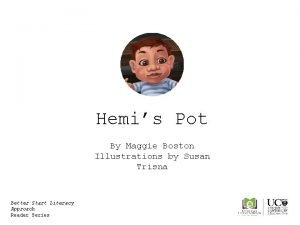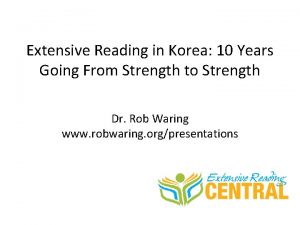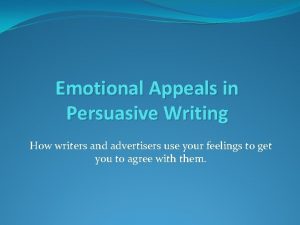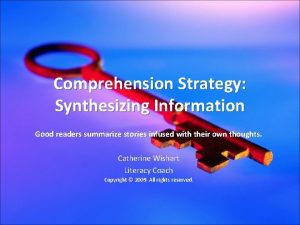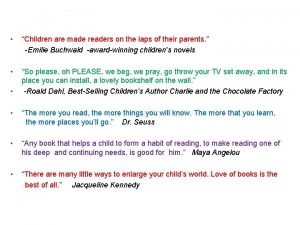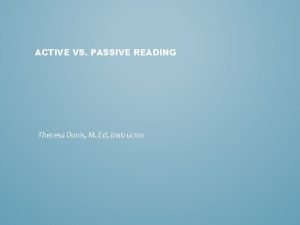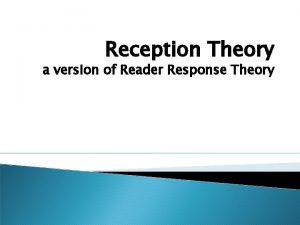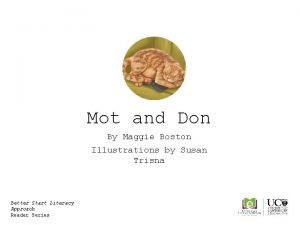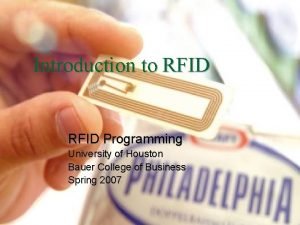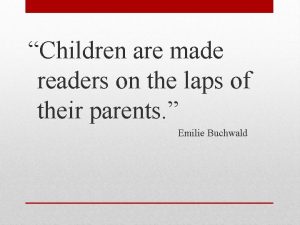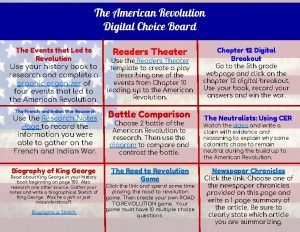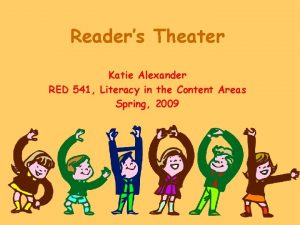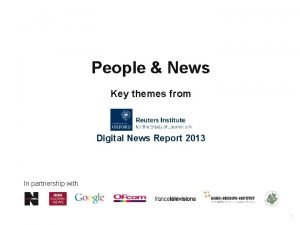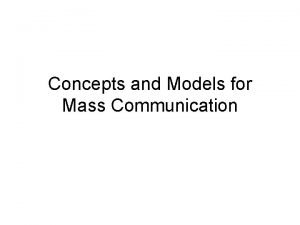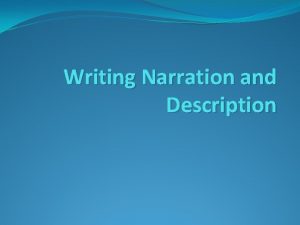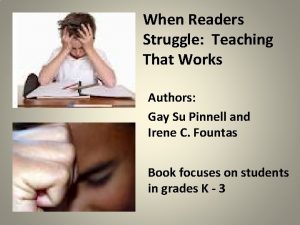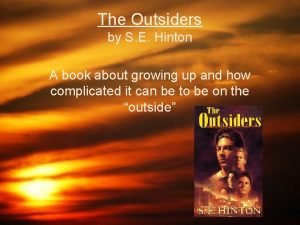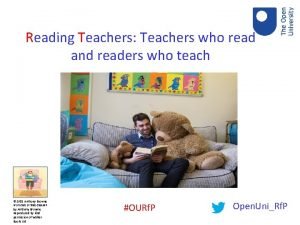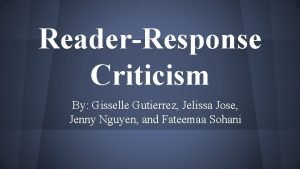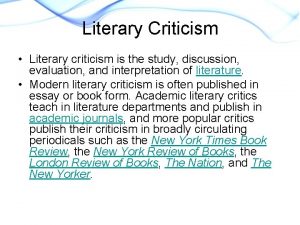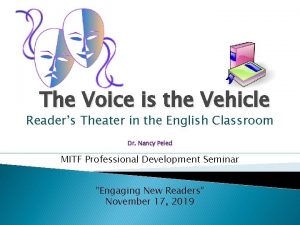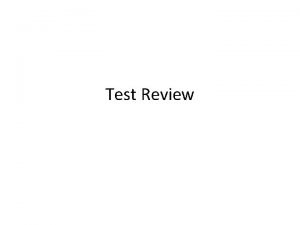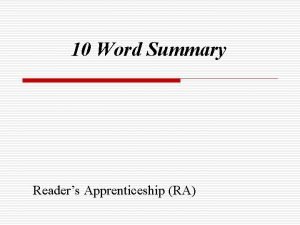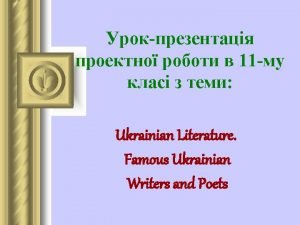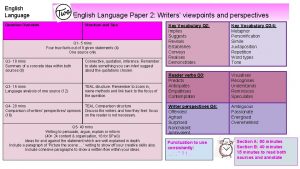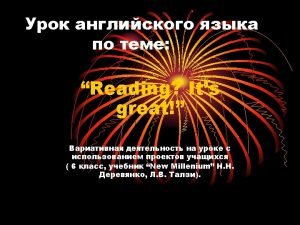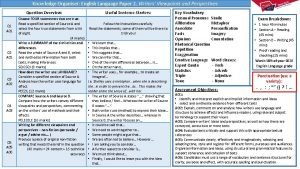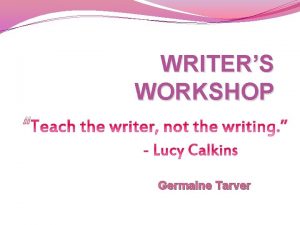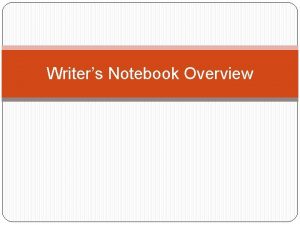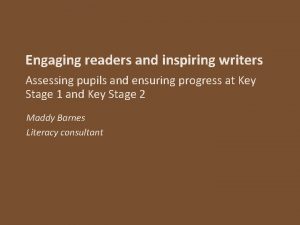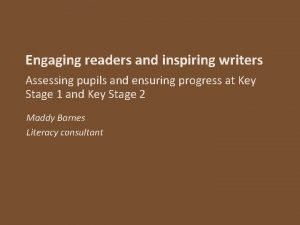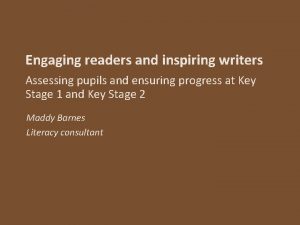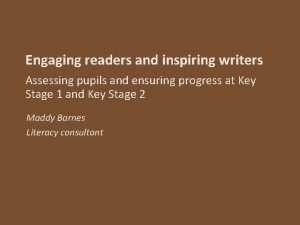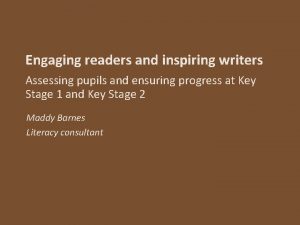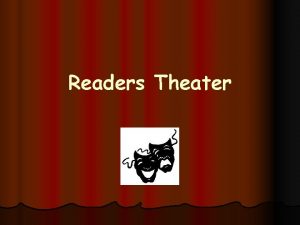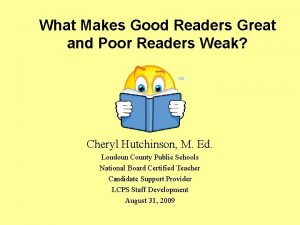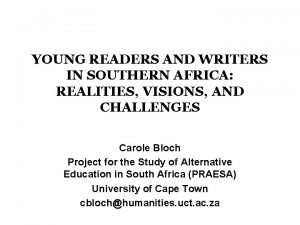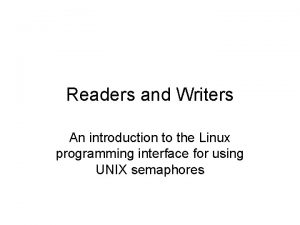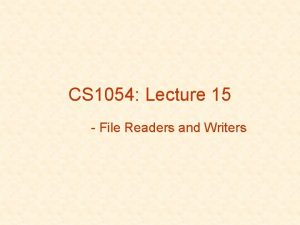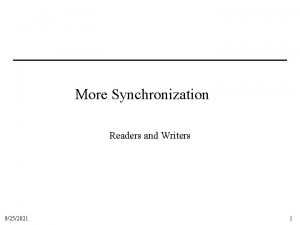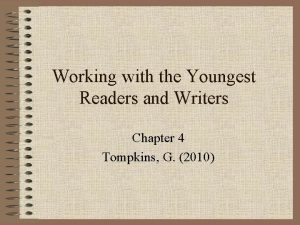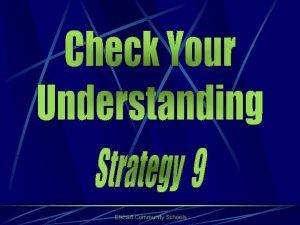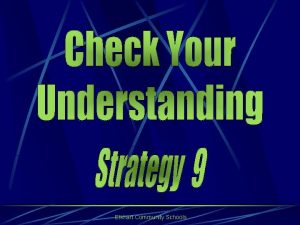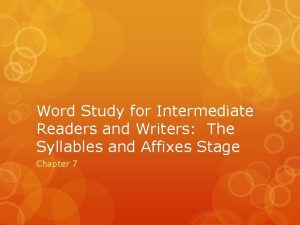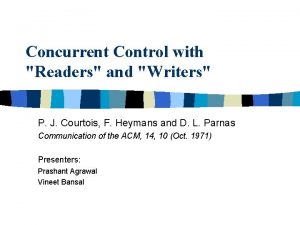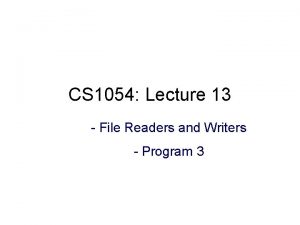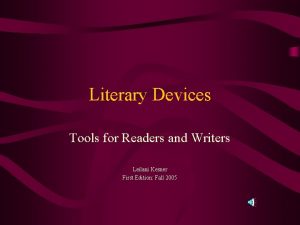We Are Readers and Writers Getting to the















































- Slides: 47

“We Are Readers and Writers!” Getting to the Heart of the Language Arts Curriculum and the Common Core October 8, 2013 New Canaan Public Schools Glenda Green & Karen Scalzo

What we always do as teachers of reading: • We model what it means to be a reader • We generate excitement about reading • We help our kids explore a variety of pathways to becoming readers • We teach reading strategies directly • We re-teach strategies when needed • We make time for independent reading every single day • We help students dig a little deeper for understanding

STRATEGIES DEMONSTRATED BY PROFICIENT READERS Proficient readers: • • Activate prior knowledge Determine important ideas/themes Ask questions Create visual and sensory images

• Draw inferences • Summarize/synthesize • Use fix-up strategies when needed

Reading is thinking and it is fun!

“This is Spoon’s family. ”

What is this book about? • What did Amy Rosenthal do to engage the reader? • How did the illustrations complement the story? • Would the story have been the same without the illustrations?

The greatest question. . . • What do you think the author wants us to understand?

Viewing reading through the lens of the Common Core State Standards The CCSS: • revolve around comprehension • have four main components: – Standards (what we teach) – Text Complexity (what we teach with) – Scaffolds (how we teach to build understanding) – Assessment (how we measure what we teach)

“Staircase Standards” Every standard is applied at every grade level with different levels of rigor.

Common Core Anchor Standards for Reading Key Ideas and Details 1. Read closely to determine what the text says explicitly and to make logical inferences from it; cite specific textual evidence when writing or speaking to support conclusions drawn from the text. 2. Determine central ideas or themes of a text and analyze their development; summarize the key supporting details and ideas. 3. Analyze how and why individuals, events, and ideas develop and interact over the course of a text.

What is the author saying? • Standard 1: explicit understanding, inferring, citing textual evidence • Standard 2: determining central ideas and themes, summarizing • Standard 3: analyzing characters

Craft and Structure 4. Interpret words and phrases as they are used in a text, including determining technical, connotative, and figurative meanings, and analyze how specific word choices shape meaning or tone. 5. Analyze the structure of texts, including how specific sentences, paragraphs, and larger portions of the text (e. g. , a section, chapter, scene, or stanza) relate to each other and the whole. 6. Assess how point of view or purpose shapes the content and style of a text.

How is the author saying it? • Standard 4: literal and nonliteral language, allusions to mythology • Standard 5: chapter, scene, stanza (grade 3) and structural elements of poems, e. g. verse, rhythm, meter (grade 4) • Standard 6: point of view

The Wall by Eve Bunting

Integration of Knowledge and Ideas 7. Integrate and evaluate content presented in diverse media and formats, including visually and quantitatively, as well as in words. 8. Delineate and evaluate the argument and specific claims in a text, including the validity of the reasoning as well as the relevance and sufficiency of the evidence. 9. Analyze how two or more texts address similar themes or topics in order to build knowledge or to compare the approaches the authors take.

Why is the author saying it? • How do the illustrations contribute to what is conveyed by the words in a story? (Standard 7)

• Compare and contrast the treatment of similar themes and topics and patterns of events in texts. (Standard 9)

Standard 9 Compare fiction with informational text:

Range of Reading and Level of Text Complexity 10. Read and comprehend complex literary and informational texts independently and proficiently.

Text Complexity What makes a text complex? • Longer, more complex sentences and vocabulary • Words with multiple meanings • Higher levels of abstraction • Complex and/or multiple themes

Approaching a Complex Text • • • Big idea or concept Important vocabulary Questions for reflection/discussion Written response Text-to-Text connections

Reading Anchor Standard #3 for Literature: Describe characters in a story and explain how their actions contribute to the sequence of events. K: With prompting and support, identify characters, settings and major events in a story. 1 st: Describe characters, settings, and major events in a story, using key details. 2 nd: Describe how characters in a story respond to major events and challenges.

3 rd: Describe characters in a story (e. g. , their traits, motivations, or feelings) and explain how their actions contribute to the sequence of events. 4 th: Describe in depth a character, setting, or event in a story or drama, drawing on specific details in the texts (e. g. , a character’s thoughts, words, or actions). From CCSS: Reading Standards for Literature

Anchor Standard #3 for Informational Text Analyze how and why individuals, events, and ideas develop and interact over the course of a text. K: With prompting and support, describe the connection between two individuals, events, ideas, or pieces of information in a text. 1 st: Describe the connection between two individuals, events, ideas, or pieces of information in a text. 2 nd: Describe the connection between a series of historical events, scientific ideas or concepts, or steps in technical procedures in a text.

3 rd: Describe the relationship between a series of historical events, scientific ideas or concepts, or steps in technical procedures in a text, using language that pertains to time, sequence, and cause/effect. 4 th: Explain events, procedures, ideas, or concepts in a historical, scientific, or technical text, including what happened and why, based on specific information in the text.

English Language Arts Standards • have connections to real life applications • are an interdisciplinary approach to literacy and content area knowledge • have technology integrated throughout • focus on analyzing text as readers and writers

NCPS Writing Curriculum

“The ultimate aim of a curriculum is independent transfer; i. e. , for students to be able to employ their learning, autonomously and thoughtfully, to varied complex situations, inside and outside of school. Lacking the capacity to independently apply their learning, a student will be neither college nor workplace ready. ” Jay Mc. Tighe and Grant Wiggins From Common Core to Curriculum

Writing Workshop Has a predictable structure every day: Ø Mini-lesson with a teaching point Strategies – ways to do things Techniques – ways to fashion things Questions – ways to think about things Relationships – ways to connect things Conventions – ways to expect things Ø Guided Practice Ø Independent Writing

Writing Workshop Over time in writing workshop, we hope to see students developing: • A sense of self as writers, as well as personal writing processes that work for them. • Ways of reading the world like writers, collecting ideas with variety, volume, and thoughtfulness. • A sense of thoughtful, deliberate purpose about their work as writers and a willingness to linger with those purposes. • As members of a responsive, literate community. • Ways of reading texts like writers, developing a sense of craft and genre in writing. • A sense of audience, and an understanding of how to prepare writing to go into the world.

Anchor Standards for Writing Text Types and Purposes 1. Write arguments to support claims in an analysis of substantive topics or texts, using valid reasoning and relevant and sufficient evidence. 2 Write informative/explanatory texts to examine and convey complex ideas and information clearly and accurately through the effective selection, organization, and analysis of content. 3. Write narratives to develop real or imagined experiences or events using effective techniques, well-chosen details, and wellstructured event sequences.

Argument Writing Progression Beginning Middle End Craft K Tell about a topic or book State opinion or preference 1 Introduce topic or book State opinion and supply a reason Sense of closure 2 Introduce topic or book State opinion and supply reasons Concluding statement or section Use linking words 3 Opinion pieces on topics or texts with organizational structure that lists reasons State opinion and support point of view with reasons Concluding statement or section Use linking words and phrases 4 Opinion pieces on State opinion topics or texts with clearly and support related ideas point of view with grouped together reasons and to support purpose information Concluding statement or section related to opinion presented Link opinion and reasons with words and phrases

Writing Workshop I think the goodest food is breadsticks because you can dip them.

I love Pie in the Sky. I love the detail words and how you tell the names of the birds at the end.




A Nation of Vidiots! Ok, this is serious. Kids in this generation are playing way too many video games. Turn off your video game system and listen to this shocking news. Are you ready? Here goes. According to a study by the Kaiser Family Foundation, kids spend about six hours a day playing video games. I can almost hear you gasping in shock. That is about half of an average kid’s day. Imagine this: you get home from school at 3: 00 and you play video games until 9: 00, then you go to sleep. Six hours a day without exercise, reading, and spending time with your family. Unbelievable. This isn’t fiction, it’s reality.

Kids who play a lot of video games are more likely to be overweight. According to Medical News Today, 30. 6% of Americans are obese. That’s more than any other country by far. I think that probably at least half of Americans are fat because they play too many video games. Sitting on a couch and staring at a screen really do not improve your health. One day, I was reading the newspaper when suddenly a headline appeared. It read: “Boy collapsed after playing World of Warcraft for 24 hours straight. ” It was due to lack of sleep, food, and water. I was shocked when I read this. That boy must have gone through day and night playing video games. That’s crazy! He nearly died, all because of playing too much video games.

Look, I know what you are thinking: video games are awesome! Really? How are they awesome? Video games may be fun, build eye hand coordination, and even help pass time, but why not try a sport or a fun activity that instead doesn’t include staring at a screen 24/7? Sports are fun, build eye hand coordination and help pass time! Plus, you get more exercise too! I really don’t get the point of playing video games. If you are looking for a fun activity that will keep you healthy and a great person, choose playing video games! NOT.

Production and Distribution of Writing 4. Produce clear and coherent writing in which the development, organization, and style are appropriate to the task, purpose, and audience. (Begins in grade 3) 5. Develop and strengthen writing as needed by planning, revising, editing, rewriting, or trying a new approach. 6. Use technology, including the Internet, to produce and publish writing and to interact and collaborate with others.

Research to Build and Present Knowledge 7. Conduct short as well as more sustained research projects based on focused questions, demonstrating understanding of the subject under investigation. 8. Gather relevant information from multiple print and digital sources, assess the credibility and accuracy of each source, and integrate the information while avoiding plagiarism. 9. Draw evidence from literary or informational texts to support analysis, reflection, and research. (Begins in Grade 4)

Range of Writing 10. Write routinely over extended time frames (time for research, reflection, and revision) and shorter time frames (a single sitting or a day or two) for a range of tasks, purposes and audiences. (Begins in Grade 3)

Common Core State Standards – are just that – standards. – are not a national curriculum. – are not an instructional framework. – are not an assessment program. www. corestandards. org

The district has approached the study of and use of CCSS in the same way we have always used state and national standards in content areas: We study the standards and use informed professional judgment to determine how best to customize them and incorporate them into the New Canaan frameworks, units and lessons. Every year district curriculum is reviewed and adjustments made to better serve the needs of our learners. As always, there will be ongoing tweaks to our rigorous curriculum, as we continue to build knowledge through content-rich nonfiction and information texts, in addition to literature; promote reading and writing grounded in evidence from the text; and provide regular practice with complex texts and academic vocabulary.

For further information: Glenda Green Reading Coordinator K-4 glenda. green@ncps-k 12. org Karen Scalzo Writing Coordinator K-5 karen. scalzo@ncps-k 12. org Common Core Website www. corestandards. org
 Antigentest åre
Antigentest åre Compare non-critical readers with critical readers.
Compare non-critical readers with critical readers. Readers writers problem
Readers writers problem The secret of getting ahead is getting started
The secret of getting ahead is getting started To persuade author's purpose
To persuade author's purpose Intensive reading characteristics
Intensive reading characteristics Convince the readers
Convince the readers Good readers make predictions by
Good readers make predictions by Maggie boston readers
Maggie boston readers Korean graded readers
Korean graded readers Appeal in persuasive writing
Appeal in persuasive writing Vivid writing examples
Vivid writing examples Reading comprehension synthesizing
Reading comprehension synthesizing Children are made readers on the laps of their parents
Children are made readers on the laps of their parents Active vs passive reading
Active vs passive reading Louise rosenblatt reader response theory
Louise rosenblatt reader response theory Maggie boston readers
Maggie boston readers Rifd readers houston
Rifd readers houston Children are made readers on the laps of their parents
Children are made readers on the laps of their parents To inform the readers/listeners about a newsworthy event.
To inform the readers/listeners about a newsworthy event. American revolution choice board
American revolution choice board ²www
²www Online readers
Online readers Concepts in mass communication
Concepts in mass communication Readers goal in narration
Readers goal in narration When readers struggle
When readers struggle The outsiders adapted for struggling readers
The outsiders adapted for struggling readers Teachers as readers
Teachers as readers Reader-response criticism example
Reader-response criticism example Readers response criticism
Readers response criticism Where the wild things are readers theater
Where the wild things are readers theater In which of these statements does henry use parallelism?
In which of these statements does henry use parallelism? Civil war readers theater
Civil war readers theater 10 word summary
10 word summary Creative writing and daydreaming by sigmund freud
Creative writing and daydreaming by sigmund freud Taras shevchenko quotes
Taras shevchenko quotes Writers viewpoints and perspectives
Writers viewpoints and perspectives Famous british poets
Famous british poets Paper 2 writers’ viewpoints and perspectives
Paper 2 writers’ viewpoints and perspectives Hình ảnh bộ gõ cơ thể búng tay
Hình ảnh bộ gõ cơ thể búng tay Ng-html
Ng-html Bổ thể
Bổ thể Tỉ lệ cơ thể trẻ em
Tỉ lệ cơ thể trẻ em Voi kéo gỗ như thế nào
Voi kéo gỗ như thế nào Tư thế worm breton là gì
Tư thế worm breton là gì Chúa yêu trần thế
Chúa yêu trần thế Các môn thể thao bắt đầu bằng tiếng đua
Các môn thể thao bắt đầu bằng tiếng đua Thế nào là hệ số cao nhất
Thế nào là hệ số cao nhất


